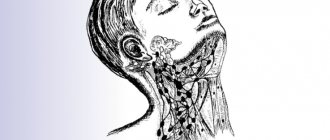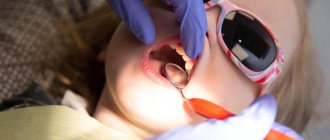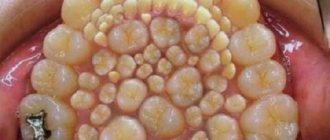Types of herpes in children
It is worth distinguishing between herpes simplex viruses type 1. This is the most well-known type of herpes simplex virus, which appears on a child's lip and is characterized by a general malaise, sometimes with a slight fever. Oral ulcers are most common in children aged 1-2 years, but they can appear in people as young as at any age and at any time of the year.
A crust on the lip of a child with herpes. Photo: victoriafly / freepik.com
The second type of herpes is genital, which manifests itself in a similar way. During childbirth, if the mother suffers from genital herpes, the baby may become infected as it passes through the birth canal. The manifestations of this type of herpes in children are more complex than in adults. Children may suffer from herpetic sore throat and stomatitis.
Herpes virus type 3 (varicella zoster virus) in children during primary infection causes chickenpox; in the secondary manifestation of the virus, the disease occurs as herpes zoster (shingles).
Chickenpox. Photo: freepik.com
Herpes type 6 in children causes roseola infantile, a pink maculopapular rash. It mainly affects children under the age of 2 years. First, a fever develops, then the temperature decreases within 3-6 days. After the temperature drops, an exanthema appears on the skin - pink maculopapular rashes 1-3 mm in size, turning pale when pressed (this is one of the distinctive signs; for the same rubella, the rash does not turn pale after pressure). They may disappear within a few hours or may persist for up to several days. The rash is localized mainly on the body, spreading to the neck, face and limbs
Infantile roseola. Photo: (Public Domain)
Herpetic viruses of types 4, 5, 6 can cause infectious mononucleosis - an acute infectious disease characterized by fever, sore throat, enlarged lymph nodes, liver and spleen, lymphocytosis, and the appearance of atypical mononuclear cells in the peripheral blood.
Cytomegalovirus, a member of the herpesvirus type 6 family, is one of the most common viruses. Children usually become infected with cytomegalovirus infection in early childhood, for example, in a nursery or kindergarten. Transmission of cytomegalovirus can only occur through direct contact with an infected person. In addition, children can be infected with the virus during fetal development. The infected environment is blood, urine, saliva and other biological substrates. Typically, cytomegalovirus in healthy children is asymptomatic or accompanied by minor symptoms similar to those of mononucleosis and disappearing after a few days or weeks.
Enlarged lymph nodes in the neck of a child with infectious mononucleosis. Photo: GMS current topics in otorhinolaryngology, head and neck surgery / Open-i (CC BY-NC-ND 3.0)
Human herpesvirus type 6 and type 7 during primary infection causes neonatal exanthema in infants. Only a specialist can accurately diagnose a child’s health condition.
Acute herpetic stomatitis in children
This stomatitis occupies one of the leading places in childhood infectious pathology; it is more common than scarlet fever, measles and mumps. It is considered as a manifestation of primary infection with the herpes simplex virus in the oral cavity. Children and teenagers get sick. The disease is contagious to persons not previously infected with the virus. In preschool institutions, school classrooms, and hospital wards, during an epidemic outbreak, up to 75% of children can get sick. Transmission of infection occurs by contact and airborne droplets. In the first 6 months of life after birth, herpes practically does not occur, which is due to the presence in the child’s blood of antiherpetic antibodies during this period, transplacentally transmitted to him from the mother. The course of the disease in the child is acute, there is a high temperature, a disturbance in the general condition, an increase in ESR, leukopenia or leukocytosis. In the pathogenesis of the disease, periods are distinguished: prodromal, catarrhal, periods of rashes and extinction of the disease.
- PRODROME PERIOD OF ACUTE HERPETIC STOMATITIS IN CHILDREN
The prodromal period is manifested by a burning sensation, piercing, itching, a feeling of tension, rawness and numbness in the areas of future appearance of the rash on the skin and mucous membrane of the mouth and lips. There is loss of appetite, poor sleep, and malaise. The child even refuses his favorite food, becomes sedentary and inactive, and, as a rule, the mother pays attention to his behavior.
Lymph nodes - submandibular, chin and cervical - can be enlarged, their palpation is painful.
- CATARHAL PERIOD OF ACUTE HERPETIC STOMATITIS IN CHILDREN
The catarrhal period is characterized by hyperemia and swelling of the oral mucosa and gingival margin. The child may complain of discomfort or pain in the mouth when eating and refuse favorite foods. Infants refuse to breastfeed or turn into lazy suckers.
Lymph nodes - submandibular, submental and cervical - are enlarged, their palpation is painful. The mucous membrane of the gums is swollen, hyperemic, and the gums bleed when touched. There is pronounced hypersalivation, bad breath, and the oral fluid is viscous and viscous.
- PERIOD OF ACUTE HERPETIC STOMATITIS RASHES IN CHILDREN
During the period of rashes, single or multiple lesions appear on the oral mucosa and skin in the form of bright hyperemic spots, against which small blisters quickly form, which can merge into large blisters. The formation of bubbles is accompanied by tingling in the oral mucosa and red border of the lips. They are located in groups and contain a clear liquid that becomes cloudy over time.
Large blisters burst quickly enough to form painful erosions with uneven contours. The erosions are covered with fibrinous plaque. Blisters localized on the lips and skin, after opening, contribute to the formation of erosions or gray-yellow crusts. The area of damage to the oral mucosa depends on the severity of the disease. The mucous membrane of the oral cavity is swollen, hyperemic, in the first 2 days hypersalivation is pronounced, which can be replaced by dryness. Erosive elements and bubbles can be multiple or single, i.e. the process can be limited (herpetic glossitis, herpetic tonsillitis), or widespread, completely affecting not only the mucous membrane of the oral cavity, but also the mucous membrane of the nasopharynx, tonsils, red border of the lips and the skin around the lips, as well as the wings of the nose. Without treatment, erosions epithelialize in 7-12 days.
The mucous membrane of the gums is also swollen, hyperemic, the gums bleed when touched, catarrhal gingivitis easily transforms into ulcerative necrotic. The submandibular, submental and cervical lymph nodes are enlarged, their palpation is painful.
- PERIOD OF EXHAUSTION OF ACUTE HERPETIC STOMATITIS IN CHILDREN
The period of extinction (reconvalescence) of acute herpetic stomatitis in children is characterized by an improvement in the general condition and dental health, hyperemia and swelling of the oral mucosa decreases and disappears, and active epithelization of aphthous elements is observed.
There are 3 degrees of severity of the disease.
- MILD DEGREE OF ACUTE HERPETIC STOMATITIS IN CHILDREN
A mild degree of acute herpetic stomatitis in children occurs with the absence of symptoms of intoxication of the body, however, with a satisfactory general condition, low-grade fever is possible. The mucous membrane of the oral cavity is swollen, hyperemic, the gums bleed, single and grouped small aphthae appear almost simultaneously in different areas of the mucosa, which quickly epithelialize.
- AVERAGE DEGREE OF ACUTE HERPETIC STOMATITIS IN CHILDREN
The average degree of acute herpetic stomatitis occurs with severe intoxication. During the prodromal period, malaise, weakness, headache, nausea, and temperature of 38.5C are observed. The submandibular lymph nodes are enlarged, less often the submental and cervical ones, their palpation is painful. The mucous membrane of the oral cavity is swollen, hyperemic, the saliva is viscous and viscous, the dentogingival papillae are swollen and bleed when touched. In various parts of the oral mucosa there are single or grouped aphthae. Increased ESR, leukopenia or leukocytosis are noted.
- SEVERE DEGREE OF ACUTE HERPETIC STOMATITIS IN CHILDREN
Severe degrees of acute herpetic stomatitis in children, already in the prodromal period, are characterized by the presence of all the signs of an infectious disease - apathy, adynamia, headache, nausea, vomiting, since the herpes virus is encephalotropic. Body temperature 38-40C. Pallor of the skin is noted. The submandibular, submental and cervical lymph nodes are enlarged, their palpation is painful. The oral mucosa is swollen, hyperemic, covered with a large number of aphthous elements that recur. The lips, mucous membrane of the cheeks, soft and hard palate, tongue, and gingival margin are affected. Dental papillae are swollen and bleed when touched. In case of insufficient oral care, catarrhal gingivitis easily transforms into ulcerative-necrotic. Saliva is viscous and viscous, the reaction of saliva is acidic, pH = 5.8-6.4. Leukopenia is detected in the blood, the number of band neutrophils increases, eosinophilia, and increased ESR are noted. Protein is detected in the urine.
IN WEAKENED CHILDREN WITH CHRONIC, LONG-TERM SOMATIC DISEASES, HERPES SIMPLE TAKES A PERMANENT COURSE, LIZEROS SIMPLE BECOMES A RECURRENT DISEASE, IN SOME CHILDREN, RECURRENCES ARE OBSERVED I DO UP TO 5 TIMES A YEAR.
Herpes in infants
Herpes in children can be more complex than in adults. Herpes is an insidious infection; herpes in an infant can cause severe damage to the nervous system and internal organs. When the visual organs are damaged, keratitis, phlebothrombosis, chorioretinitis, and iridocyclitis occur. If the ENT organs are damaged, sudden deafness, herpetic sore throat and damage to the inner ear may occur. Damage to the cardiovascular system manifests itself in the form of myocarditis, atherosclerosis and myocardiopathy. If the herpes virus penetrates the central nervous system, there is a risk of encephalopathy, meningitis, and nerve plexuses are affected. Herpes can also lead to schizophrenia and depressive disorders. On the part of the reproductive system, reproductive function, urethritis, prostatitis (in men), colpitis, endometritis and chorionitis (in women) are possible.
Herpes symptoms
Symptoms of herpes in children are traditional: there may be fever, fatigue, muscle pain, and irritability. Pain, burning, tingling and itching occur at the site of future infection rashes. The rash is accompanied by subsequent ulceration and the formation of wounds. Children tend to scratch wounds until they bleed, constantly touch them, and tear off the crusts that have formed, which complicates healing and prolongs its duration. At best, simple herpes on a child's lip heals within a few days. Ulcers can also occur in the mouth: on the gums, the front of the tongue, the inside of the cheeks, the throat and the roof of the mouth. The gums may be slightly swollen, red, and may bleed. They may also spread down the chin and neck. The lymph nodes in the neck often become swollen and painful. In children, the herpes virus can infect the mucous membrane of the throat with the formation of small ulcers and a grayish coating on the tonsils. Because the ulcers are painful, it may be difficult to eat or drink. A sick child should not eat solid or hot foods during the period of oral herpes. If the wound is constantly injured, healing may take two weeks or more. Parents need to control this process.
Manifestations of the disease
Clinical manifestations of herpes depend on many factors - the type of virus, location of the lesion, age and immune status of the person. The classic symptomatology is the appearance of a group of small bubbles filled with clear liquid. Herpes is characterized by the appearance of blisters during the next relapse, always in the same place.
When localized in the upper half of the body, rashes occur mainly on the lips (the so-called “cold”), as well as on the mucous membrane of the nose, mouth, conjunctiva of the eyes, in the area of the ear canal and on the eyelids.
With the genital version of herpes, the rashes are localized on the labia, on the skin of the perineum, inner thighs, pubis, or around the anus.
A few days before the rash appears, there may be a feeling of itching and discomfort at the site of future rashes (herpetic “bell”).
The rash is accompanied by unpleasant sensations, itching, burning, and pain. Then the bubbles burst, and in their place first ulcers and then crusts form. Herpetic sores are typically painful, and the crusts that form in their place disappear without a trace after 2-3 days, leaving no pigmentation or scars on the skin.
The general symptoms of the disease are very diverse: increased body temperature, enlarged lymph nodes (usually inguinal), joint and muscle pain, persistent migraines, irritability, lack of appetite, etc.
The typical clinical picture appears in no more than a third of cases of carriage of genital herpes. Often, genital herpes is asymptomatic or without characteristic rashes.
The atypical course of herpes is more insidious: the absence of blistering rashes is more than compensated by the variety of general manifestations, which often creates difficulties in making the correct diagnosis. Symptoms of atypical herpes are burning, cracks in the perineum, labia or anus, swelling, redness of the mucous membranes. In such cases, the diagnosis is often made incorrectly, or women who are confident that they have candidiasis (thrush) or bacterial vaginosis self-medicate to no avail.
The severity of any manifestations of herpes infection is determined by the state of the immune system.
Treatment of herpes in children
To treat herpes infection, antiviral drugs, immunostimulants, and interferons are used. Treatment of infection must begin at the first suspicion of the disease, recovery depends on this, advanced infection becomes chronic or recurrent, and the likelihood of complications increases. Treatment of herpes in children is aimed at minimizing the manifestation of symptoms and suppressing the activity of the virus. For this purpose, antiviral drugs are used - ointments and tablets that relieve itching and pain. It is necessary to take large amounts of fluid, as well as antipyretics when body temperature rises to high levels.
Photo: MedPortal
An antiviral drug used for herpes infection is acyclovir. This drug can be used either as an intravenous injection or as tablets. The method of administration of the drug depends on the severity of the disease and its form. The drug is administered intravenously at a dosage of 30-60 mg/kg of the child’s body weight, orally – 90 mg/kg. Taking the drug should be divided into 3-4 parts. This drug can also be used externally in the form of an ointment. It must be applied to the affected areas of the skin and mucous membranes 4-5 times a day.
Immunostimulating drugs help the child’s body fight the virus more effectively and prevent the virus from infecting new areas of the mucous membranes and internal organs. For treatment, you can use immunostimulating drugs such as Immunal, Groprinosin, Arpetol.
Interferons help destroy viruses and prevent them from multiplying uncontrollably. They can be used both in tablet form and in the form of suppositories. Suppositories are inserted into the child's anus 2 times a day for 5 days, the course is repeated 2-3 times with a break of 5 days.
If the disease recurs quite often, you need to contact an immunologist who will give qualified advice that can significantly increase the immunity of a weakened child. Among other things, treatment of herpes in children should be supervised by a doctor, since only a specialist can calculate the correct dosage that is safe for the child’s body.
The herpes virus, once in a child’s body, remains in it for life, periodically exacerbating, causing temporary discomfort. The main task of parents is to help the child, strictly following the instructions of the pediatrician. When solving an existing problem, special attention is paid to maintaining hygiene and providing the baby with individual means, such as a towel, soap, and a washcloth. The child should wash his hands more often. If there is herpes in the mouth, the child should not be allowed to injure herpes sores.
Newborn herpes
20.09.2012 26300
A very unpleasant and dangerous disease!
Herpetic infection is the most common human viral infection, existing in the body mainly in a latent form and manifested against the background of immunodeficiency states by lesions of the skin, mucous membranes, eyes, liver and central nervous system. It is the most commonly diagnosed infection among congenital and neonatal diseases. Relevance. Infection of the adult population with herpes simplex viruses reaches 90-95%. In recent years, there has been an increase in the number of cases of herpes infection in newborns all over the world. The mortality rate from neonatal herpes reaches 50-70%. Only 15% remain healthy; many children subsequently suffer from severe neurological diseases.
Etiology. The herpes simplex virus is part of the herpes virus family, divided into herpes simplex virus type 1 - labial and herpes simplex virus type 2 - genital. Genital herpes is the most dangerous for the fetus.
The herpes simplex virus consists of three main components: a nucleotide, a capsid, and a lipid-containing envelope. The genome is represented by linear double-stranded DNA.
Epidemiology. The natural host of the herpes simplex virus is humans. Ways of transmission of infection:
- airborne;
— sexual (is the main one for herpes simplex virus type 2);
- contact (when the fetus passes through the mother's birth canal during childbirth, the infection rate is 40-50%, morbidity - 20%, mortality - 40%);
-vertical (the risk of transmission during a primary infection in a pregnant woman is 50%, with the first clinical manifestation of a non-primary infection - up to 33%, with a recurrence of herpetic infection - up to 3%);
- transplacental.
Most often, the disease is transmitted to the fetus during childbirth from the mother, who has an infected birth canal and often has a chronic urinary tract infection. The entrance gates can be injured skin, mucous membranes of the lips, mouth, nose, conjunctiva and genitals. Vertical transmission of infection from mother to fetus can occur through damaged and even intact placenta. Infection is accompanied by viral replication at the site of invasion. Further, it is able to spread neurogenically, lympho- and hematogenously. The favorite localization is the sensory ganglia, where the infection can persist for a long time.
Clinical picture. Symptoms Manifestations of congenital herpes infection depend on the timing of infection. A reliable connection has been established between herpes infection and malformations of the gastrointestinal tract, heart, genitourinary system, skeleton, and congenital cicatricial deformities of the skin. The herpes virus can cause organic damage to the central nervous system (micro- and hydrocephalus, cerebral palsy, epilepsy), liver cirrhosis, neonatal hepatitis, severe damage to the eyes, lungs, skin and mucous membranes. The incubation period ranges from 2 to 30 days. There are 3 clinical forms of herpes infection in newborns:
1) Localized form with damage to the skin and mucous membranes of the mouth, eyes - occurs in 20-40% of patients. It is characterized by the presence of single or multiple vesicular elements in various parts of the body in the absence of signs of a systemic inflammatory reaction. Bubbles measuring 1.5-2 mm against a background of erythema and edema. Most often they appear on days 5-14 of life. When they are opened, erosions with a smooth bottom are formed. There may be unstable pigmentation at the site of erosion; the healing process lasts approximately 10-14 days. The development of herpetic keratoconjunctivitis, chorioretinitis, corneal erosions, uveitis, episcleritis or iridocyclitis is possible. In some cases, specific optic neuritis is observed. In the absence of specific treatment, in 50-70% of newborns, the localized cutaneous form can lead to generalization of the process or damage to the central nervous system.
2) The generalized form accounts for 20 to 50% of cases of neonatal herpes. The onset of the disease is most often on the 5-11th day of life, but an earlier manifestation is possible in the first 24-48 hours of life. Clinical symptoms are nonspecific and resemble neonatal sepsis: lethargy, regurgitation, increase or decrease in body temperature, severe microcirculation disturbance, apnea, cyanosis, shortness of breath, and sometimes signs of pneumonia. Characteristic is the involvement of the liver and adrenal glands in the pathological process. An enlarged spleen, hypoglycemia, hyperbilirubinemia, disseminated intravascular coagulation syndrome, and signs of infectious-toxic shock are observed. 50-60% of patients experience symptoms of herpetic meningoencephalitis. Specific rashes on the skin and mucous membranes appear on days 2-8 from the onset of the disease, however, in 20% of newborns with a generalized form of HI, no skin elements are found.
3) Herpetic lesions of the central nervous system (encephalitis, meningoencephalitis) account for about 30% of cases. The development of clinical symptoms of the disease in most cases is observed in the 2-3rd week of life (12-17th days of life). The disease begins with a rise in body temperature, lethargy, alternating with episodes of increased excitability, tremor, decreased appetite, followed by the rapid development of poorly controlled focal or generalized convulsions. At first, the cerebrospinal fluid may not be changed, then an increase in protein content and cytosis of a lymphocytic or mixed nature are detected. 40-60% of patients do not have specific herpetic eruptions on the skin and mucous membranes. With antenatal infection, the birth of children with microcephaly, hydrocephalus, and the presence of intracranial calcifications is possible.
Diagnosis of herpes infection:
• Of particular importance is the assessment of the mother’s specific medical history (chronic somatic pathology, cervical erosion, salpingoophoritis, colpitis, spontaneous abortions, non-developing pregnancy, antenatal fetal death, herpetic rashes on the skin and mucous membranes of the mother during this pregnancy).
• Clinical examination of the patient: in children born to mothers with acute or recurrent herpes infection, examination of the skin and mucous membranes must be carried out with special care in order to early identify herpetic elements.
• If a newborn has seizures of unknown etiology, a lumbar puncture is indicated. With herpetic meningoencephalitis, a high concentration of protein and lymphocytosis/monocytosis are observed in the cerebrospinal fluid.
• If clinical sepsis occurs in a newborn, in which it is not possible to achieve the effect of targeted antibacterial therapy, it is necessary to conduct laboratory tests for herpes infection.
• Additional clinical-laboratory and clinical-instrumental studies (clinical and biochemical tests of blood and urine, neurosonography, computed tomography of the brain, if indicated - EEG, coagulogram, computed tomography, chest x-ray) allow us to assess the condition of individual organs, systems and the degree their involvement in the pathological process.
• Herpetic etiology of the disease must be confirmed by special laboratory methods:
— the “gold standard” is the isolation of the virus from blood, cerebrospinal fluid, vesicle contents and other loci (nasopharynx, conjunctiva) in tissue culture (sensitivity up to 100%, specificity 100%, analysis duration of at least 5 days);
— electron microscopy;
- cytological diagnostics, based on microscopic examination of tissue preparations stained using the Wright-Giemsa, Papanicolaou method;
— the contents of the vesicles can be examined using a direct immunofluorescent method to detect the herpes simplex virus antigen;
— detection of the virus genome in blood and cerebrospinal fluid using the polymerase chain reaction method (sensitivity of the method - 95%, specificity - 90-100%, analysis time - 1-2 days);
- detection of specific IgG and IgM antibodies to HSV by ELISA in the blood, cerebrospinal fluid (which is of great importance for the diagnosis of this infection, the causative agent of which has an extremely pronounced tropism for the nervous system), urine, and nasopharyngeal contents. The method of “paired sera” taken for research with an interval of 10-14 days is of particular diagnostic value in newborns and infants. An increase in immunoglobulin titer by 4 or more times during this period confirms the diagnosis of herpes infection.
• Pathomorphology of the placenta. Macroscopically, the membranes of the placenta are yellowish and cloudy. Histological examination reveals basal deciduitis. Typical herpetic cells are large in size, with basophilic inclusions in the nucleus, surrounded by a rim of clearing. The cytoplasm of the cells is initially weakly basophilic, then strongly acidophilic. In all damaged villi, activation of fixed macrophages (Hoffbauer-Kashchenko cells) occurs. Hemorrhages, fibrin deposits and thrombus formation, multiple foci of necrosis and calcification are found in the basal lamina.
Treatment of herpes infection. For all forms of neonatal herpes infection, specific antiviral therapy is indicated, since the localized form may precede the generalization of the infection. In newborns with localized forms of the disease, acyclovir is used intravenously at a dose of 45 mg/kg/day; for a generalized form of infection and meningoencephalitis - at a dose of 60 mg/kg/day. Enteral administration of acyclovir in newborns may not be effective enough. Duration of treatment: localized form – 10-14 days; generalized form and meningoencephalitis - at least 21 days. For herpetic eye lesions, you can use a 1% solution of iododioxyuridine, a 3% solution of vidarabine, and a 1-2% solution of trifluridine. Damaged skin is treated with Acyclovir and Zavirax ointment 3 times a day.
Among herbal preparations that have a noticeable antiviral effect, derivatives of licorice and St. John's wort are most often used in the treatment of herpes infection. These products are used mainly locally. Thus, epigen, produced on the basis of glycyrrhizic acid salts, significantly reduces the healing time of mucocutaneous lesions.
In case of a generalized form of infection in conditions of an immunodeficiency state, polyspecific intravenous immunoglobulins (Octagam, Intraglobin, Sandoglobin, Pentaglobin) and immunoglobulins with a high titer of antibodies to the herpes simplex virus can be used in complex therapy of newborns, including premature infants. An integral part of the pathogenetic therapy of herpes infection is also the use of interferon-type drugs: Viferon-1 in suppositories (dose 150,000 IU once a day per rectum for 5 days). Maintaining the vital functions of a child’s body with a generalized form of neonatal herpes is carried out in accordance with the general principles of intensive care. An important place in the treatment of herpetic meningoencephalitis is occupied by adequate anticonvulsant therapy. It makes no sense to stop breastfeeding a child, since even with a primary infection in the mother, the penetration of HSV into milk is unlikely. The exception is when the mother has herpetic rashes located on the chest.
Prevention of herpes infection.
1) Identification of high-risk pregnant women:
a) a thorough history taking to identify episodes of genital herpes;
b) a thorough clinical examination of the birth canal, perineum and vulva during observation in antenatal clinics and before the onset of labor; c) virological confirmation of herpes-like genital lesions in all women planning pregnancy.
2) Management of pregnancy and childbirth should be based on clinical principles and anamnesis:
a) in women with a primary clinical episode of herpes infection less than 6 weeks before birth, a planned cesarean section is necessary;
b) if the episode occurred more than 6 weeks before birth, vaginal delivery is possible; to reduce the risk of exacerbation of the disease at the time of birth, it is advisable to use acyclovir from 36 weeks of pregnancy;
c) disseminated and severe primary maternal infection require treatment with acyclovir, regardless of the stage of pregnancy;
d) in the presence of genital herpes in the mother and natural birth, newborns are subject to examination and preventive therapy with acyclovir. If a negative laboratory test result for herpes infection is obtained and there are no clinical manifestations of the disease, antiviral therapy is stopped.
Outcomes of neonatal herpes infection. With early administration of antiviral therapy, mortality in generalized forms of infection is less than 50%, while in the absence of specific treatment it is 90%; with meningoencephalitis – 14%. The incidence of neurological complications ranges from 10 to 43%; recurrences of skin manifestations in the first 6 months of life are observed in 46% of children.
Sources
- Lenart M., Działo E., Kluczewska A., Węglarczyk K., Szaflarska A., Rutkowska-Zapała M., Surmiak M., Sanak M., Pituch-Noworolska A., Siedlar M. miRNA Regulation of NK Cells Antiviral Response in Children With Severe and/or Recurrent Herpes Simplex Virus Infections. // Front Immunol - 2021 - Vol11 - NNULL - p.589866; PMID:33679688
- Gündoğdu M., Erden N., Karagun E., Acıpayam AŞF., Vural S. Annual pattern and clinical characteristics of herpes zoster in immunocompetent children in a rural area. // Dermatol Ther - 2021 - Vol34 - N1 - p.e14570; PMID:33219711
- Huang CW., Hsieh CH., Lin MR., Huang YC. Clinical features of gingivostomatitis due to primary infection of herpes simplex virus in children. // BMC Infect Dis - 2021 - Vol20 - N1 - p.782; PMID:33081701
- Cosme I., Ramírez MA., Peñata CA., Beltrán-Arroyave C., Florez ID. Human Herpes Virus 6 Detection in Children With Suspected Central Nervous System Infection. // Pediatr Infect Dis J - 2021 - Vol39 - N12 - p.e469-e471; PMID:32925539
- Weinmann S., Irving SA., Koppolu P., Naleway AL., Belongia EA., Hambidge SJ., Jackson ML., Klein NP., Lewin B., Liles E., Marin M., Smith N., Weintraub E. ., Chun C. Incidence of herpes zoster among varicella-vaccinated children, by number of vaccine doses and simultaneous administration of measles, mumps, and rubella vaccine. // Vaccine - 2021 - Vol38 - N37 - p.5880-5884; PMID:32444193
- Kanamori K., Shoji K., Kinoshita N., Ishiguro A., Miyairi I. Complications of herpes zoster in children. // Pediatr Int - 2021 - Vol61 - N12 - p.1216-1220; PMID:31628883
- Aktaş H., Erdal SA., Güvenç U. Herpes Zoster in children: Evaluation of the sixty cases. // Dermatol Ther - 2021 - Vol32 - N6 - p.e13087; PMID:31515892
- Hwang JH., Kim KH., Han SB., Kim HH., Kim JH., Lee SY., Choi UY., Kang JH. A clinical-epidemiological multicenter study of herpes zoster in immunocompetent and immunocompromised hospitalized children. // Clin Exp Vaccine Res - 2021 - Vol8 - N2 - p.116-123; PMID:31406693
- Agharbi FZ. . // Pan Afr Med J - 2021 - Vol32 - NNULL - p.199; PMID:31312311
- Pittet LF., Curtis N. Does oral antiviral suppressive therapy prevent recurrent herpes labialis in children? // Arch Dis Child - 2019 - Vol104 - N9 - p.916-919; PMID:31311776










